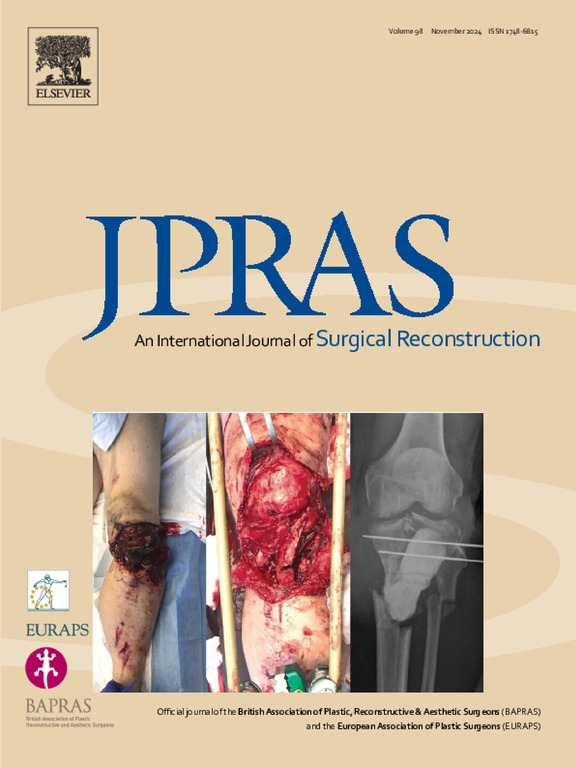Biomechanical modeling of finger flexion based on imaging data: Implications on trigger finger surgery
IF 2
3区 医学
Q2 SURGERY
Journal of Plastic Reconstructive and Aesthetic Surgery
Pub Date : 2025-02-27
DOI:10.1016/j.bjps.2025.02.047
引用次数: 0
Abstract
Purpose
The risk of bowstringing increases significantly after an excessive release of the A2 pulley in patients with trigger finger. However, the safe extent of this release has not yet been determined. Using a biomechanical model of finger flexion, we examined tendon excursion efficiency and moment arms relative to finger joints. This analysis allowed us to determine the safe extent of A2 pulley release.
Methods
Computed tomography and magnetic resonance imaging data of eight subjects were used for the modeling. We simulated the incremental release of the A1 and A2 pulleys and compared moment at the metacarpophalangeal (MCP) and proximal interphalangeal (PIP) joints for each degree of the release. In addition, we calculated the excursion length of the flexor digitorum profundus (FDP) necessary for achieving maximum PIP joint flexion.
Results
With respect to the MCP joint, the moment arm remained unchanged throughout the pulley release. However, with respect to the PIP joint, the moment arm increased significantly when the release reached the proximal half of the A2 pulley. For maximum PIP joint flexion, a significantly larger FDP excursion was required when half of the A2 pulley was released than in the intact finger (26.6 mm vs. 16.3 mm).
Conclusions
Our imaging-based biomechanical model of finger flexion effectively evaluated tendon excursion efficiency and moment arms with respect to the MCP and PIP joints according to the precise level of pulley release. The model demonstrated that extending the release up to the proximal half of the A2 pulley increases the risk of bowstringing. This imaging-based biomechanical modeling may be applied to predict tendon excursion efficiency after various hand surgeries.
基于影像数据的手指屈曲生物力学建模:扳机指手术的意义
目的:扳机指患者过度松解A2滑轮后弓弦形成的风险明显增加。然而,这次释放的安全程度尚未确定。使用手指屈曲的生物力学模型,我们检查了肌腱偏移效率和相对于手指关节的力矩臂。该分析使我们能够确定A2滑轮释放的安全程度。方法利用8例被试的计算机断层扫描和磁共振成像数据进行建模。我们模拟了A1和A2滑轮的增量释放,并比较了每个程度释放时掌指关节(MCP)和近端指间关节(PIP)的力矩。此外,我们计算了实现最大PIP关节屈曲所需的指深屈肌(FDP)的偏移长度。结果对于MCP关节,在整个滑轮释放过程中,力臂保持不变。然而,对于PIP关节,当释放到达A2滑轮的近半部分时,力臂明显增加。对于最大的PIP关节屈曲,当A2滑轮的一半被释放时,所需的FDP偏移明显大于完整手指(26.6 mm对16.3 mm)。结论基于超声成像的手指屈曲生物力学模型可根据滑轮释放的精确水平,有效评估MCP和PIP关节的肌腱偏移效率和力矩臂。该模型表明,将释放延伸至A2滑轮的近半会增加弓弦的风险。这种基于成像的生物力学模型可用于预测各种手部手术后肌腱漂移的效率。
本文章由计算机程序翻译,如有差异,请以英文原文为准。
求助全文
约1分钟内获得全文
求助全文
来源期刊
CiteScore
3.10
自引率
11.10%
发文量
578
审稿时长
3.5 months
期刊介绍:
JPRAS An International Journal of Surgical Reconstruction is one of the world''s leading international journals, covering all the reconstructive and aesthetic aspects of plastic surgery.
The journal presents the latest surgical procedures with audit and outcome studies of new and established techniques in plastic surgery including: cleft lip and palate and other heads and neck surgery, hand surgery, lower limb trauma, burns, skin cancer, breast surgery and aesthetic surgery.

 求助内容:
求助内容: 应助结果提醒方式:
应助结果提醒方式:


